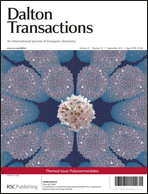Bi-alkylimido functionalization of hexamolybdates has been developed and several novel di-substituted alkylimido hexamolybdates with n-butyl, cyclohexyl and tert-butylamines as the imido-releasing reagents have been synthesized in reasonable yields. Their structures have been characterized by elemental analysis, IR, UV-Vis, and ESI mass spectrometry. Moreover, the structures of [Mo6O17(NCy)2]2− and [Mo6O17(NCMe3)2]2 have been determined by single-crystal X-ray diffraction techniques. It is notable that the compound (Bu4N)2[Mo6O17(NCy)2] crystallizes in polar space group Fdd2 with potential ferroelectricity. In addition, theoretical investigation of the reactivity and regioselectivity of bi-alkylimido functionalization has also been conducted. The calculation results show that more energy is required for the bi-functionalization process than for the mono-substitution process, and that the cis-bi-functionalization is the kinetically favored process while trans-[Mo6O17(NR)2]2− is the thermodynamically favored product.

You have access to this article
 Please wait while we load your content...
Something went wrong. Try again?
Please wait while we load your content...
Something went wrong. Try again?


 Please wait while we load your content...
Please wait while we load your content...